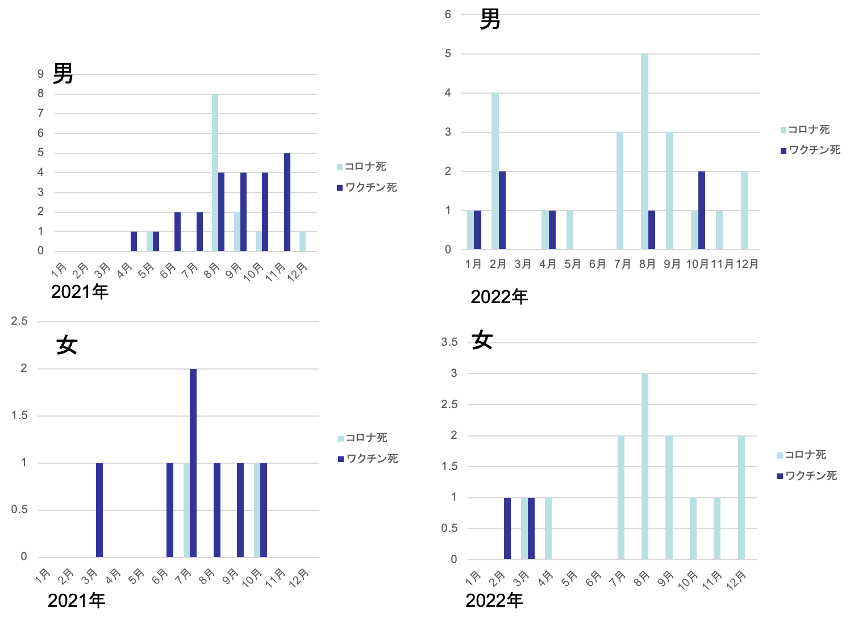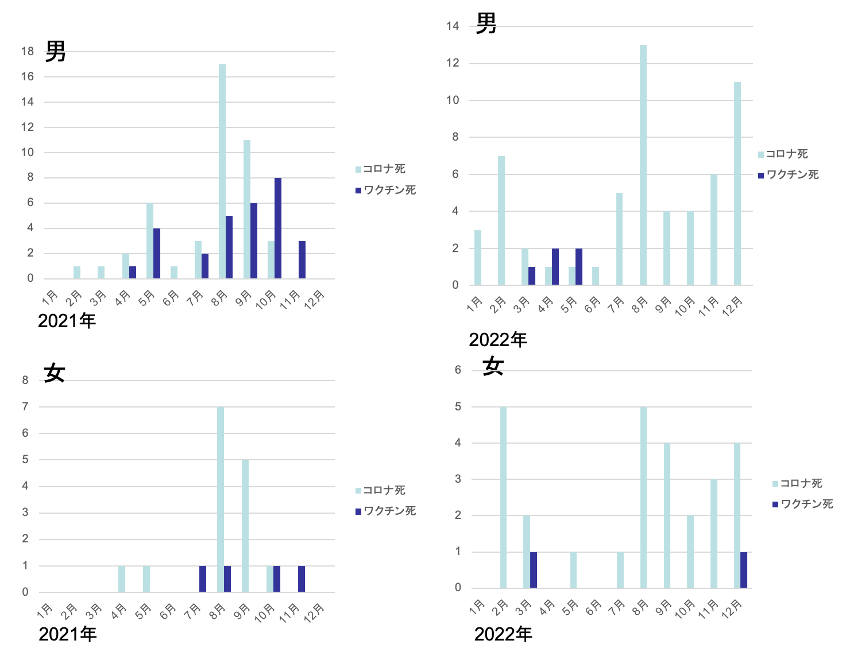Nagoya Uni prof continues post-vax death analysis
Continuing the theme of his previous article (and by extension, mine), Nagoya University’s Prof Seiji Kojima extended his analysis of post-vax deaths to people aged 20-49. The background to this article is the government’s announcement that they’re going to build a database to track vaccine safety data. The database is planned to go into operation in 2026, which along with the new mRNA factory recently built in Fukushima demonstrates Japan’s continued commitment to offering endless Covid shots to everyone aged 6 months and over. But as Prof Kojima shows, you don’t need to build a database to find safety signals. In fact, you don’t even need much data at all.
All quoted text is by Prof Kojima, and all highlights are my own.
Figure 1 shows the number of deaths from Covid-19 compared to reported post-vaccination deaths by gender for 20- to 29-year-olds. In 2021, among men, there were 23 deaths reported after vaccination and 13 deaths due to Covid, meaning that deaths due to vaccines exceeded deaths due to coronavirus. Among women, there were 7 deaths reported after vaccination, but only 2 from Covid. In 2022, there were 22 Covid deaths and 7 post-vaccine deaths among men, and 13 Covid deaths and 2 post-vaccine deaths among women.

Figure 2 shows a comparison of the number of deaths due to Covid and the number of reported deaths after vaccination for men and women aged 30 to 39. In 2021, there were 48 Covid deaths and 29 post-vaccine deaths among men. Among women, there were 15 Covid deaths and 4 post-vaccine deaths. In 2022, there were 58 Covid deaths and 5 post-vaccine deaths among men, and 27 Covid deaths and 2 post-vaccine deaths among women.

Figure 3 shows a comparison of the number of deaths due to Covid and the number of deaths after vaccination for men and women aged 40 to 49. In 2021, there were 234 Covid deaths and 34 vaccine deaths among men, and 46 Covid deaths and 20 vaccine deaths among women. In 2022, there were 133 Covid deaths and 10 post-vaccine deaths among men, and 86 Covid deaths and 6 post-vaccine deaths among women.

One generous interpretation of the 2021 data is that the only group under 50 for whom the “benefits outweighed the risks” was men in their 40s. But as I wrote last time, you need to bear in mind that post-vax deaths are even more under-reported in Japan than elsewhere. For example, Japan has reported fewer post-vax deaths than the UK (2180 vs 2459) despite having almost twice the population and giving far more shots per capita. Anyway, how do we know the post-vax deaths aren’t due to chance?
Both Covid deaths and post-vaccine deaths were more common among men than women, with men in their 20s and 30s being 3.3 and 5.7 times more likely to die after vaccines than women. Not all deaths after vaccination are caused by the vaccine, and many deaths are thought to be coincidental. However, in 2021, all-cause deaths among people in their 20s and 30s was 1.9 times and 1.7 times higher for men than for women. Coincidental mortality does not explain gender differences in vaccine deaths.
It is known that many men in their 20s and 30s suffer from myocarditis and pericarditis after getting the Covid vaccine. Among fatal cases in their 20s, five of the six people diagnosed with myocarditis were men. Of the 10 cases of fatal arrhythmia, 9 were also male. Among the fatal cases in their 30s, all 11 cases diagnosed with myocarditis and 5 cases diagnosed with fatal arrhythmia were male, indicating a significant gender difference.
The reason the number of deaths after vaccination among young adults is higher among men than among women is thought to be because deaths from myocarditis and pericarditis are more common in this age group.
…
Over the two years, there were 149 deaths among young adults following vaccination, of which 79 deaths were due to myocarditis/pericarditis, fatal arrhythmia, heart failure, and sudden death, accounting for half of the deaths.
So how did the Japaneses authorities manage not to see these brightly flashing safety signals? By claiming blindness.
In 2021 and 2022, there were 30 reported deaths from post-vaccination myocarditis in young adults, of which 18 were autopsied. But even after a pathologist's diagnosis of myocarditis/pericarditis based on autopsy findings, the Adverse Reactions Investigation Committee (ARIC) of the Health and Welfare Science Council judges all cases as “causality cannot be evaluated” because of a lack of information.
One committee member made the following comment.
“The patient developed fulminant myocarditis and died 3 days after vaccination, and autopsy revealed extensive myocarditis in the left ventricle. Although the diagnosis of myocarditis had been confirmed, there was also the possibility of myocarditis caused by viral infection, so we thought that a causal relationship with the vaccine could neither be confirmed nor denied.”
Apparently, even an autopsy isn’t sufficient information. You’ll notice the ARIC doesn’t require any evidence of viral myocarditis, just the “possibility”. In response, Prof Kojima makes a point so obvious that only an expert could miss it: who gets jabbed when they’re feeling sick?
They acknowledge myocarditis, but since myocarditis can also be caused by a viral infection, they argue that the vaccine cannot be determined to be the cause. Normally, if you have a viral infection such as upper respiratory tract infection or gastroenteritis that causes myocarditis, you will not get vaccinated. Moreover, the onset of myocarditis occurs within 3 to 4 days after vaccination in most cases. Is it possible to contract a viral infection that can cause myocarditis in such a short time?
But vaccine-sceptics don’t just have to rely on basic logic to make our point.
Recently, an American study reported biomarkers suggesting a direct relationship between myocarditis and vaccination. Free-floating spike proteins were detected in the blood of 13 (81%) of 16 young people who had developed myocarditis within 19 days after vaccination. On the other hand, free-floating spike proteins were not detected in vaccinated patients didn’t develop myocarditis.
Spike proteins are produced by vaccination and are known to cause dysfunction of cardiac pericytes and inflammation of endothelial cells, so it is quite possible that spike proteins cause myocarditis.
All but two of the 30 deaths reported in Japan due to myocarditis/pericarditis were young adults whose symptoms developed within two weeks after vaccination, and based on this report from the United States, 80% of these deaths can be thought to be due to vaccination.
I think even 80% is a bit low, but it’s closer to the truth than the 0% insisted upon by the ARIC.
However, Japan’s Health Damage Investigation Subcommittee has so far paid compensation to the families of 26 people who died from post-vax myocarditis/pericarditis or fatal arrhythmia and compensated 364 people who needed medical attention after post-vax myocarditis/pericarditis. But compensation can be paid out without causality being proven as long as causality can’t be disproven. Put less convolutedly, the compensation payments (totaling 210 for deaths and 3669 for medical attention as of writing) are NOT official acknowledgements of vaccine harms. When it comes to recognising safety issues, the ARIC is the committee whose opinion actually matters.
The Ministry of Health, Labor and Welfare has announced that it will develop a database to study the efficacy and safety of the coronavirus vaccine over the next three years. I think the purpose of this is to obtain the basis for making decisions about whether vaccinations should continue.
I think the purpose is to build a digital database of vaccine data linked to people’s digital IDs. But opinions can differ for now I suppose.
In this analysis, there were more deaths after vaccination than deaths due to Covid among people in their 20s in 2021. Nevertheless, considering that Covid vaccinations are still continuing, the criteria for discontinuing vaccinations need to be decided in advance.
Clear criteria would be nice. But if the authorities don’t want the criteria to be met, then they won’t be. Or to better sum up the past few years, they didn’t want any criteria to be met, so they weren’t.


“I think the purpose of this is to obtain the basis for making decisions about whether vaccinations should continue.” IF that were the case, why set it up to run in 2026 and still push for boosters in the mean time. I think your reason, to match vax status to My Number is the real reason.
Thx for the breakdown! If only the powers that be were not nefarious.